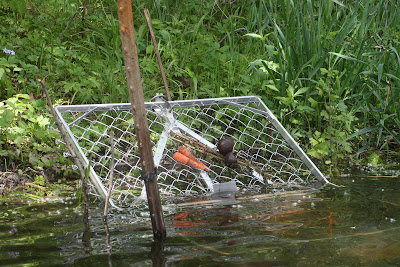BRING IT ON!
So the cute furry beaver was now the big bad enemy. (See entry for March 30.) He was eyeing the woods, and he was getting a little cheeky with the tail slapping, too. We called Trapper Ben.
 |
| WANTED! |
“Do not kill the beaver. Do not hurt the beaver. Just relocate the beaver where it will be happy.”
Trapper Ben was on board with all of this, but he didn’t own a live trap big enough for this dude. We had to buy one. Guess the price.
Did you guess $450? I looked at my checkbook and pondered that beaver’s life. I looked at the woods. I bit the bullet.
The trap was huge and heavy. Trapper Ben set it out with some tasty treats that appeal to beavers––corn leaves, carrots. He knew right where to put it vis-à-vis the lodge and the pile-o-scat. So we waited. And waited. We met with Trapper Ben and affirmed our desire to live-trap the animal. He knew all about the satellite dens cut into the pond bank under water. That’s where beavers house their yearlings while they raise the new batch. He rerouted the pond run-off pipe because running water sends a message to beavers, and its beaver brain responds, “Damn! I must build a dam!”
The food remained in the trap. The trap remained unsprung. The lodge grew into the Mackinaw Hotel. There were more stumps in the woods. The summer was drawing to a close. When I kayaked around the colossus, I could hear baby beavers squealing and mewing in the lodge. Awwwww. Awwww, my foot! We were about to host lots more beavers!
By September, we were growing weary of the battle. One day I was walking around the pond and found that a beautiful, tall oak had been felled. It was likely 50 years old. I called Ben.
There was a knock, I opened the front door, and Ben stood on the front porch.
“Kill the little bugger! Kill them all!” I shouted. I waited for the regret. And right on cue, there it was––I regretted paying $450 for a trap! Nope, the pelts in summer aren’t useful. I read your mind.
And kill the buggers he did. I asked him not to show them to me; I felt bad enough. They were big, he reported, as in 60 lbs. of big. And numerous.
Finally, I had to look. Did I feel bad? Yeah, a little, even though I had done everything I could to give those guys a chance. But beavers reproduce like the rodents they are, while it takes a tree somwhere in the neighborhood of 50 years to become 50 years old.
Ben dismantled the lodge so it wouldn’t be colonized by future beavers. It took him all day, and apparently it wasn’t an easy task. Ben looked like he had wrestled those beavers out of there by hand. The lodge was impressive. There were three levels, and each level had two doors of its own. Okay, so then I felt a little bad. They are amazing beasts. They will be just as amazing over on the English River when they can't get through our new fence below the pond.
 |
| Tree Killer! |
To see a wonderful video on beavers building a lodge:
http://www.youtube.com/watch?v=VuMRDZbrdXc















































